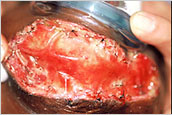| Inspection and Care
of the Site |
|


During the early stages of development take
note of the following:

- Remove all dressings to inspect INTEGRA™
Bilayer Matrix Wound Dressing sites, seams, and
edges for evidence of hematomas, fluid accumulation,
infection/purulence, and areas of non-take.

- If used,
re-moisten antimicrobial dressings after INTEGRA™
Bilayer Matrix Wound Dressing inspection. Irrigation
tubing can be used to re-moisten or re-apply without
removing dressings.

- Re-moisten or re-apply antimicrobial
dressings as needed, typically every eight hours, or
more often for dry climates

- Replace or change antimicrobial dressings
at least every three days. Note: For heavily draining
wounds, more frequent dressing changes may be necessary.
When removing dressings to inspect INTEGRA™
Bilayer Matrix Wound Dressing sites, care should
be taken to avoid dislodgement. As you gain experience
with INTEGRA™ Bilayer Matrix
Wound Dressing, your frequency of inspection and
dressing changes is likely to change from this schedule.
Movement / Outpatient Care
As shearing will result in the NON-TAKE of INTEGRA™
Bilayer Matrix Wound Dressing, the goal for the staff
and patient is to minimize these forces on the INTEGRA™
Bilayer Matrix Wound Dressing site. Bolsters, splints
and Ace Wrap compression (an important outer dressing
during the first 24-48 hours) will help protect from friction
and shear of INTEGRA™ Bilayer Matrix Wound Dressing
from the excised bed.